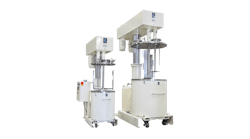From mixers and pumps to valves and fillers, the range of equipment and machinery used in the food, beverage and water industry is diverse. Each has its own set of sealing requirements and understanding these critical components takes expertise. Caio Beraldo, Trelleborg’s Technical Manager for Food, Beverage, and Water, recently connected with Processing to discuss the uses and sealing needs for horizontal mixers.
Q: What are horizontal mixers?
Horizontal mixers are used for solid-on-solid mixing and for applications like dough mixing involving coating a dry particle with a liquid ingredient. A horizontal mixer contains a shaft in the center of a tub and a flywheel connected to a drive motor via a chain or belt drive. The flywheel moves ingredients from one end of the mixer to the other, discharging the mixed ingredients from the bottom using the same mixer blade action. Horizontal mixers come in three configurations: ribbon blenders, paddle/plough mixers and drum mixers.
Q: What’s the difference between these configurations?
A ribbon blender has a U-shaped horizontal trough and specially fabricated ribbon agitator, consisting of an inner and outer set of helical agitators. The outer ribbon moves ingredients in one direction, and the inner ribbon moves the ingredients in the other direction. Mixed ingredients can then be discharged through the center of the bottom — the most efficient method — or at the end.
Similar to a ribbon blender, a paddle or plough mixer has blades attached to arms that spin on a shaft to mix ingredients. Both versions have counter-current flow patterns that keep the ingredients blended uniformly during operation.
A drum mixer has a tumbler system and drum container. It is designed specifically for continuous, gentle mixing by agitating the contents of the drum; the agitator is optional and can fit through the standardized bung at the drum’s opening.
Q: What specifically are these mixers used for?
Ribbon blenders are suitable for pharmaceuticals, nutraceutical and dietary supplements, pet food, protein powder mixes, dry juice mixes, raw or cooked meat, ragouts, rice, ratatouille, rillettes, corned beef, pork sausage meat, baking mixes, flour, grains, spices and herbs, candy and confectionary, gum, syrups, sauces, cereals, snack bars, trail mixes, infant food, coffee, tea, chocolate, protein drinks and powdered juices.
Drum mixers are used for rotary scalping, clump breaking or rotary polishing, and to distribute and mix coatings and additives. Ingredients are fed into the drum and a spray system distributes liquid coating as the drum rotates. They are best suited for trail mixes, spice mixes, pet food, breakfast cereals, granola, snack foods, cooked rice, pectin fruit snacks, raisins, dried fruit, tea, dried peas, lentils and legumes.
Q: What kind of critical sealing components are needed in horizontal mixers?
In horizontal mixers the primary sealing concerns are with ingredient loss through the lid, drive axis and discharge valves. Additionally, sealing is needed to ensure steady speeds for a homogeneous blend. Finally, low maintenance seals extend the life of the mixer and their sanitary design ensures the mixed ingredients are not contaminated.
Q: What types of seals help protect these components of horizontal mixers?
It’s important to remember that seals used in the food and beverage industry must meet regulatory requirements while improving productivity. They must be compatible with different food types and ingredients, such as fats, oils and acids. In addition, hygienic design, and resistance to cleaning media are top priorities.
When talking about all versions of horizontal mixers, several seals are needed including ribbon/drive axis seals, wear rings for vibration absorption, discharge valve seals, and lid, thread and flange seals.
Q: What unique sealing solutions can Trelleborg offer for these applications?
Our FoodPro material range covers all the main elastomer types, PTFE-based compounds and engineered plastics and are fully compliant with global regulations such as US FDA CFR 21, European Union Regulation (EC) 1935/2004, GMP (Good Manufacturing Practices), 3-A Sanitary Standard Class I, China GB and others. Therefore, it does not matter where customers are manufacturing or shipping their final product; we have all the regulations covered. That makes us a one stop shop for sealing elements. We have dedicated manufacturing lines for our FoodPro products, unique and flexible solutions due to our tooling capabilities and are in full control of the supply chain.


